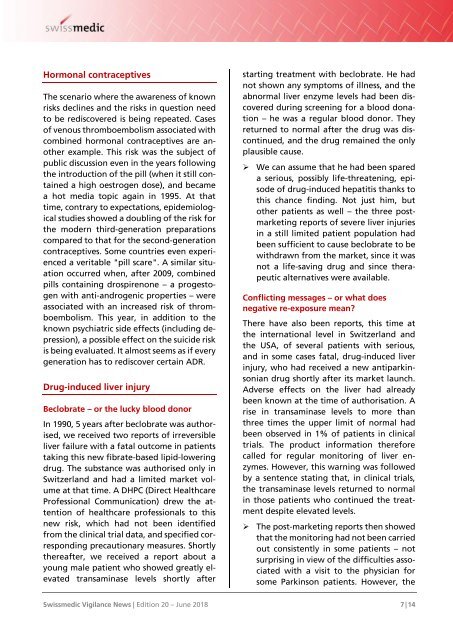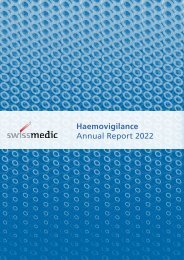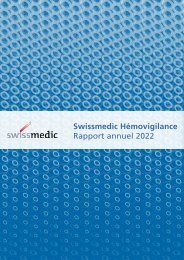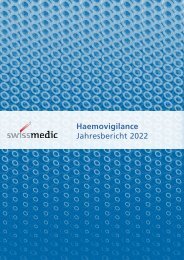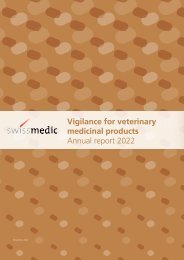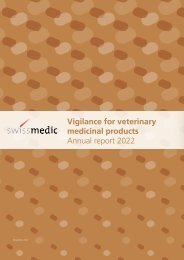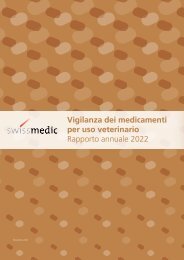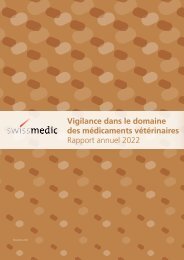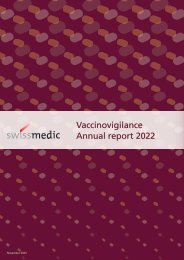Swissmedic Vigilance News Edition 20 – June 2018
Special issue: The history and development of pharma-covigilance in Switzerland over the last three decades
Special issue: The history and development of pharma-covigilance in Switzerland over the last three decades
You also want an ePaper? Increase the reach of your titles
YUMPU automatically turns print PDFs into web optimized ePapers that Google loves.
Hormonal contraceptives<br />
The scenario where the awareness of known<br />
risks declines and the risks in question need<br />
to be rediscovered is being repeated. Cases<br />
of venous thromboembolism associated with<br />
combined hormonal contraceptives are another<br />
example. This risk was the subject of<br />
public discussion even in the years following<br />
the introduction of the pill (when it still contained<br />
a high oestrogen dose), and became<br />
a hot media topic again in 1995. At that<br />
time, contrary to expectations, epidemiological<br />
studies showed a doubling of the risk for<br />
the modern third-generation preparations<br />
compared to that for the second-generation<br />
contraceptives. Some countries even experienced<br />
a veritable "pill scare". A similar situation<br />
occurred when, after <strong>20</strong>09, combined<br />
pills containing drospirenone <strong>–</strong> a progestogen<br />
with anti-androgenic properties <strong>–</strong> were<br />
associated with an increased risk of thromboembolism.<br />
This year, in addition to the<br />
known psychiatric side effects (including depression),<br />
a possible effect on the suicide risk<br />
is being evaluated. It almost seems as if every<br />
generation has to rediscover certain ADR.<br />
Drug-induced liver injury<br />
Beclobrate <strong>–</strong> or the lucky blood donor<br />
In 1990, 5 years after beclobrate was authorised,<br />
we received two reports of irreversible<br />
liver failure with a fatal outcome in patients<br />
taking this new fibrate-based lipid-lowering<br />
drug. The substance was authorised only in<br />
Switzerland and had a limited market volume<br />
at that time. A DHPC (Direct Healthcare<br />
Professional Communication) drew the attention<br />
of healthcare professionals to this<br />
new risk, which had not been identified<br />
from the clinical trial data, and specified corresponding<br />
precautionary measures. Shortly<br />
thereafter, we received a report about a<br />
young male patient who showed greatly elevated<br />
transaminase levels shortly after<br />
starting treatment with beclobrate. He had<br />
not shown any symptoms of illness, and the<br />
abnormal liver enzyme levels had been discovered<br />
during screening for a blood donation<br />
<strong>–</strong> he was a regular blood donor. They<br />
returned to normal after the drug was discontinued,<br />
and the drug remained the only<br />
plausible cause.<br />
‣ We can assume that he had been spared<br />
a serious, possibly life-threatening, episode<br />
of drug-induced hepatitis thanks to<br />
this chance finding. Not just him, but<br />
other patients as well <strong>–</strong> the three postmarketing<br />
reports of severe liver injuries<br />
in a still limited patient population had<br />
been sufficient to cause beclobrate to be<br />
withdrawn from the market, since it was<br />
not a life-saving drug and since therapeutic<br />
alternatives were available.<br />
Conflicting messages <strong>–</strong> or what does<br />
negative re-exposure mean?<br />
There have also been reports, this time at<br />
the international level in Switzerland and<br />
the USA, of several patients with serious,<br />
and in some cases fatal, drug-induced liver<br />
injury, who had received a new antiparkinsonian<br />
drug shortly after its market launch.<br />
Adverse effects on the liver had already<br />
been known at the time of authorisation. A<br />
rise in transaminase levels to more than<br />
three times the upper limit of normal had<br />
been observed in 1% of patients in clinical<br />
trials. The product information therefore<br />
called for regular monitoring of liver enzymes.<br />
However, this warning was followed<br />
by a sentence stating that, in clinical trials,<br />
the transaminase levels returned to normal<br />
in those patients who continued the treatment<br />
despite elevated levels.<br />
‣ The post-marketing reports then showed<br />
that the monitoring had not been carried<br />
out consistently in some patients <strong>–</strong> not<br />
surprising in view of the difficulties associated<br />
with a visit to the physician for<br />
some Parkinson patients. However, the<br />
<strong>Swissmedic</strong> <strong>Vigilance</strong> <strong>News</strong> | <strong>Edition</strong> <strong>20</strong> <strong>–</strong> <strong>June</strong> <strong>20</strong>18 7 | 14


